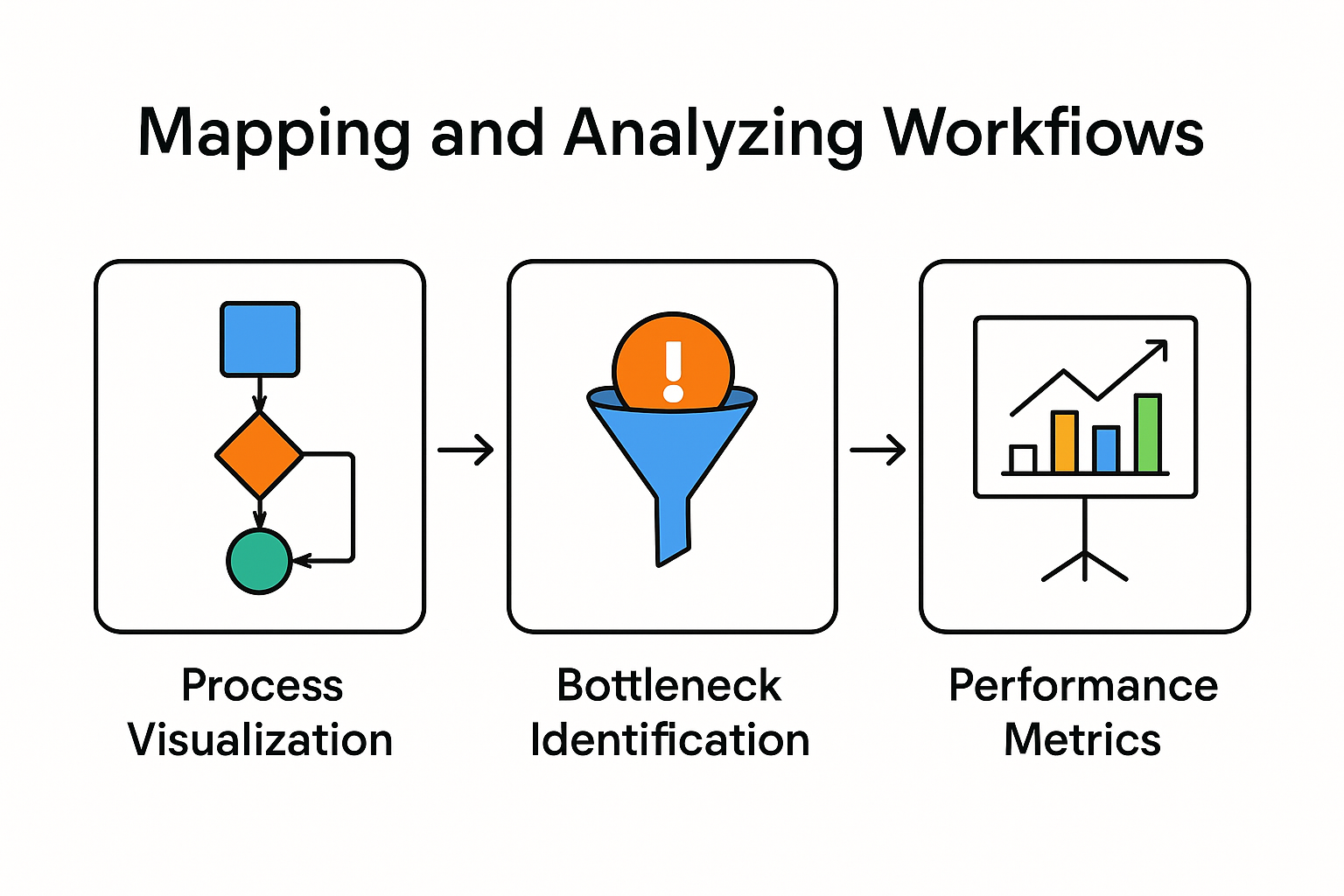Every team wants to work faster and smarter, but lining up projects and people can feel like managing a circus. Here’s a surprise. Visual workflow management tools have been shown to significantly raise productivity and improve communication across teams, especially in early project stages. The real magic happens when teams combine the right structure with flexibility, turning the chaos of daily tasks into a smooth system that does not just get work done but actually brings everyone together.
Table of Contents
- Understanding Workflow Organization Basics
- Best Practices For Designing Efficient Workflows
- Tools And Techniques To Streamline Workflows
- Overcoming Common Workflow Management Challenges
Quick Summary
| Takeaway | Explanation |
|---|---|
| Define Clear Processes | Clearly outline the steps for each task to enhance efficiency and reduce misunderstandings. |
| Utilize Visualization Tools | Use tools like Kanban boards and Gantt charts to clarify workflows and aid team coordination. |
| Encourage Continuous Feedback | Establish mechanisms for ongoing team feedback to adapt workflows and improve team collaboration effectively. |
| Invest in Collaboration Technologies | Implement integrated communication platforms to facilitate real-time information sharing and reduce delays. |
| Prioritize Adaptability | Foster a flexible culture that embraces change, allowing workflows to evolve with organizational needs. |
Understanding Workflow Organization Basics
Workflow organization is the strategic approach of designing, implementing, and managing how work gets completed within a team or organization. At its core, this process involves creating systematic methods to coordinate tasks, optimize productivity, and ensure seamless collaboration across different team members and departments.
The Fundamental Components of Workflow Management
Effective workflow organization goes beyond simple task tracking. Discover advanced team coordination strategies by understanding its critical components. According to Western Governors University, successful workflow management requires several key elements:
- Process Definition: Clearly outlining the specific steps required to complete a task or project
- Resource Allocation: Strategically assigning team members with appropriate skills and capacity
- Performance Tracking: Establishing measurable metrics to evaluate workflow efficiency
The National Center for Biotechnology Information emphasizes that workflow design is not a one-time event but a continuous process of adaptation. Teams must remain flexible, regularly reviewing and adjusting their workflows to address changing organizational needs and external challenges.
To help visualize the essential components of effective workflow management, the table below summarizes key elements and their descriptions as highlighted in this section.
| Component | Description |
|---|---|
| Process Definition | Clearly outline specific steps required for tasks/projects |
| Resource Allocation | Assign team members with appropriate skills and capacity |
| Performance Tracking | Set measurable metrics to evaluate workflow efficiency |
| Flexibility/Adaptation | Regularly review and adjust workflows for changing conditions |
Principles of Effective Workflow Design
Creating an optimized workflow requires a methodical approach. Lumen Learning’s Principles of Management highlights several critical principles for developing robust workflow systems:
-
Clarity of Roles: Each team member should understand their specific responsibilities and how their work connects to broader organizational goals.
-
Communication Channels: Establish clear communication protocols that enable smooth information exchange and reduce potential bottlenecks.
-
Scalability: Design workflows that can adapt and expand as team size and project complexity increase.
The ultimate goal of workflow organization is not just completing tasks but creating a systematic approach that enhances overall team performance. By implementing structured yet flexible workflow management techniques, organizations can significantly improve productivity, reduce errors, and create a more engaged and efficient work environment.
Understanding workflow organization is more than a technical exercise—it’s about creating a framework that empowers teams to perform at their highest potential. When done correctly, it transforms individual efforts into cohesive, strategic outcomes that drive organizational success.
Best Practices for Designing Efficient Workflows
Designing efficient workflows requires a strategic approach that balances systematic processes with flexibility and human dynamics. Learn advanced workflow optimization techniques to transform how your team operates and achieves its goals.
Mapping and Analyzing Workflow Processes
Successful workflow design begins with comprehensive process mapping. According to Atlassian, effective workflow management boosts productivity by creating clear, repeatable processes that minimize confusion and maximize efficiency.
Key steps in mapping workflows include:

- Process Visualization: Create detailed diagrams that illustrate each step of work processes
- Bottleneck Identification: Analyze current workflows to detect potential obstacles or inefficiencies
- Performance Metrics: Establish quantifiable indicators to measure workflow effectiveness
Carnegie Mellon University’s Eberly Center emphasizes the importance of dedicating time to developing teamwork skills that support effective workflow management. This includes training team members in task assessment, strategic planning, and collaborative problem solving.
Implementing Adaptive Workflow Strategies
Workflow design is not a static process but a dynamic approach that requires continuous refinement. According to Western Governors University, efficient workflow management leads to multiple organizational benefits:
- Enhanced Productivity: Streamlined processes reduce time wasted on redundant tasks
- Improved Quality: Clear workflow guidelines minimize errors and inconsistencies
- Reduced Staff Stress: Well-designed workflows provide clarity and predictability
- Better Time Management: Structured processes help teams prioritize and allocate resources effectively
Successful workflow strategies involve:
- Regular process reviews and updates
- Encouraging team feedback and input
- Utilizing technology and automation tools
- Maintaining flexibility to adapt to changing organizational needs
The most effective workflows balance structure with adaptability. They provide clear guidelines while remaining responsive to evolving team dynamics and project requirements. By implementing these best practices, organizations can create workflow systems that not only improve operational efficiency but also foster a culture of continuous improvement and collaborative success.
Tools and Techniques to Streamline Workflows
Streamlining workflows requires strategic implementation of modern tools and techniques that enhance team productivity and collaboration. Explore advanced automation strategies to transform how your team manages tasks and projects.
Workflow Visualization and Management Tools
Visual workflow management has become essential for modern teams. According to research from Kanban studies, visual tools significantly improve communication and work coordination, especially during early project phases. Key visualization techniques include:
- Kanban Boards: Create visual representations of work progress
- Gantt Charts: Track project timelines and interdependencies
- Process Mapping Diagrams: Illustrate complex workflow sequences
Atlassian emphasizes that effective workflow management tools can dramatically boost productivity by providing clear, real-time insights into team performance and project status.

Collaboration and Communication Technologies
Modern workflow optimization relies heavily on integrated communication platforms. A comprehensive review of collaboration tools highlights the critical role of technologies that facilitate seamless team interaction. Essential collaboration techniques include:
- Real-time messaging platforms
- Integrated project management software
- Cloud-based document sharing systems
- Video conferencing tools
These technologies enable teams to:
- Reduce communication delays
- Centralize project information
- Enable remote and hybrid work environments
- Track project progress in real-time
Automation and Workflow Optimization Strategies
Advanced workflow management goes beyond manual tracking. Implementing intelligent automation can transform how teams operate. Key strategies include:
- Identifying repetitive tasks for automation
- Integrating AI-powered workflow management tools
- Creating standardized process templates
- Implementing intelligent task routing systems
The goal of workflow tools is not to replace human creativity but to eliminate administrative burdens. By selecting the right combination of technologies and techniques, teams can create more efficient, transparent, and responsive work environments.
Successful workflow optimization requires continuous evaluation and adaptation. Teams must remain flexible, regularly assessing their tools and techniques to ensure they align with evolving organizational needs and technological advancements.
Overcoming Common Workflow Management Challenges
Workflow management is rarely a smooth journey. Organizations frequently encounter obstacles that can derail productivity and team collaboration. Discover proven task management strategies to navigate these challenges effectively.
Identifying and Addressing Workflow Barriers
According to Atlassian, workflow management challenges typically stem from several core issues. Understanding these barriers is the first step toward creating more resilient and adaptive work processes.
Common workflow obstacles include:
- Resistance to Change: Team members hesitant to adopt new processes
- Communication Breakdowns: Unclear communication channels and expectations
- Technological Limitations: Inadequate tools that fail to support team needs
Better Minute emphasizes that lack of workflow standardization represents a significant challenge. Organizations must develop clear, repeatable processes that can be consistently implemented across different teams and projects.
The following table outlines common workflow management challenges and corresponding strategies for overcoming them, based on insights provided in the article.
| Challenge | Description | Resolution Strategy |
|---|---|---|
| Resistance to Change | Hesitance to adopt new processes | Secure leadership support; involve team in design |
| Communication Breakdowns | Unclear channels or expectations | Establish clear communication protocols; feedback |
| Technological Limitations | Inadequate tools for team needs | Invest in appropriate, integrated technology |
| Lack of Standardization | Processes inconsistently applied | Develop repeatable, clear processes across teams |
Strategies for Effective Challenge Resolution
Overcoming workflow management challenges requires a strategic and empathetic approach. KanBo suggests several key strategies for addressing workflow obstacles:
- Secure Leadership Support: Ensure executive teams understand and champion workflow improvements
- Design Collaborative Processes: Involve team members in workflow design to increase buy-in
- Implement Continuous Feedback Mechanisms: Create channels for ongoing process evaluation
- Invest in Appropriate Technology: Select tools that genuinely support team workflow needs
Building a Culture of Workflow Adaptability
Successful workflow management transcends technical solutions. It requires creating an organizational culture that values flexibility, continuous learning, and collaborative problem solving.
Key principles for building workflow adaptability include:
- Encouraging open communication about process challenges
- Providing regular training on workflow management techniques
- Celebrating process improvements and team innovations
- Maintaining a growth mindset that views challenges as opportunities for refinement
Workflow challenges are not insurmountable obstacles but opportunities for organizational growth. By approaching these challenges with strategic thinking, empathy, and a commitment to continuous improvement, teams can transform potential roadblocks into pathways for enhanced productivity and collaboration.
Remember that workflow management is an ongoing journey. No single solution fits all scenarios. Teams must remain flexible, continuously learn, and be willing to adapt their approaches as organizational needs evolve.
Frequently Asked Questions
What are the key components of effective workflow management?
Effective workflow management includes process definition, resource allocation, performance tracking, and flexibility/adaptation to changing conditions.
How can visualization tools improve team productivity?
Visualization tools like Kanban boards and Gantt charts clarify workflows, enhance team coordination, and allow for real-time tracking of project progress, thereby boosting productivity.
What strategies can be used to overcome common workflow management challenges?
To overcome workflow challenges, secure leadership support, design collaborative processes, implement continuous feedback mechanisms, and invest in appropriate technology that addresses team needs.
How important is adaptability in workflow management?
Adaptability is crucial as it allows workflows to evolve with organizational needs, ensuring teams remain flexible, responsive to changes, and engaged in continuous improvement.
Transform Your Team’s Workflow into Seamless Productivity
Are you tired of chaotic workdays and missed deadlines because your team’s workflow is scattered and inefficient? The article explains how unclear processes, poor communication, and lack of task visibility often leave teams struggling to deliver on time or stay aligned. If you are looking for ways to finally organize your projects and free your team from the recurring headaches of manual tracking and miscommunication, it is time for a smarter solution.

Experience how Gammatica.com can help you take control of your workflow. With AI-powered project management, visual Kanban boards, and real-time team collaboration tools, you can bring clarity and structure to every project. Start using automation, pre-made templates, and integrated calendar coordination to save hours each week. Visit Gammatica.com now and see how easy it is to organize workflows and empower your team to succeed. Your next productive milestone is just a click away.
Recommended
- How to Manage Tasks Effectively in 2025: Proven Strategies for Leaders | Gammatica
- Automation for Small Businesses: Essential Strategies for 2025 | Gammatica
- Lead Management for Beginners: 2025 Guide for Teams and Leaders | Gammatica
- Project Progress Tracking: Strategies for Success in 2025 | Gammatica



